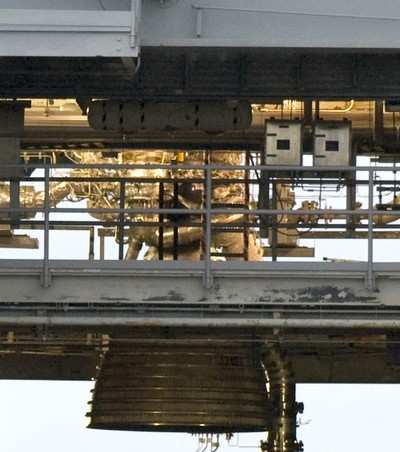First Constellation Element To Accomplish Milestone
What's old is new again... and, it's the best candidate for the
job. NASA's high-performance J-2X rocket engine -- a modern
derivative of the same motor that launched Saturn V rockets to the
moon 40 years ago -- successfully completed its critical design
review Thursday at NASA's Marshall Space Flight Center in
Huntsville, AL.

The J-2X engine, developed for NASA by Pratt and Whitney
Rocketdyne of Canoga Park, CA is the first element of NASA's
Constellation Program to pass this design milestone. The engine
will power the upper stage of NASA's next-generation Ares I rocket
and the Earth departure stage of the Ares V heavy cargo launch
vehicle.
The Constellation Program is responsible for developing this new
fleet of rockets, as well as the Orion crew capsule and the Altair
lunar lander that will send explorers to the International Space
Station, the moon and beyond.
"The approval today by the upper stage engine critical design
review board signals the beginning of manufacturing and full-scale
testing of this high-performance engine," said Steve Cook, manager
for the Ares Projects at Marshall. "This is a testament to the
team's hard work during the past three years and validates our
continued development of this important element of Ares I and V
rockets."
The board is comprised of engineers and project managers,
including representatives from the Safety and Mission Assurance
organization, who reviewed the detailed designs of the new engine.
The critical design review demonstrated the maturity of the
engine's design and concluded that the planned technical approach
meets NASA's requirements for propulsion of the Ares I upper stage.
Full-scale testing will begin in the fall of 2010.
"The design of this propulsion system confirms that Ares I is
proceeding on a solid foundation -- built on years of experience by
an eager team of engineers," said Teresa Vanhooser, chairperson for
the J-2X Critical Design Review Board. "Our goal is to build the
safest and most reliable system possible to carry our future
explorers on missions of exploration."
The J-2X engine is expected to be the most efficient engine of
its type ever built. The high efficiency is achieved by using
advanced design turbopumps, fuel injectors and a large extension
added to the nozzle -- the large, bell-shaped structure through
which exhaust gases are expelled with great force as they are
burned by the engine. NASA says these enhancements will deliver
greater thrust while burning fuel more efficiently.
The J-2X development follows the Constellation Program's goals
to seek commonality between the Ares I and Ares V systems, and use
proven hardware and knowledge from 50 years of American spaceflight
experience to streamline development and reduce program, technical
and budget risks.
"We now are ready for the challenges ahead as we move to build
and test this new engine," said Mike Kynard, manager of the Upper
Stage Engine Element for the Ares Projects at Marshall. "The J-2X
engine design process has been a rewarding endeavor, offering a
once-in-a-lifetime opportunity to develop this high-performance
rocket engine that will play a vital role in America's future in
space."
Marshall manages the Ares projects and is responsible for design
and development of the Ares I and Ares V vehicles. NASA's Johnson
Space Center in Houston manages the Constellation Program, which
includes the Ares I, the Ares V, the Orion and the Altair. NASA's
Kennedy Space Center in Florida is responsible for program ground
and launch operations. The program also includes multiple
project-element teams at NASA centers and contract organizations
around the United States.
 Bolen Gives Congress a Rare Thumbs-Up
Bolen Gives Congress a Rare Thumbs-Up The SportPlane Resource Guide RETURNS!!!!
The SportPlane Resource Guide RETURNS!!!! Buying Sprees Continue: Textron eAviation Takes On Amazilia Aerospace
Buying Sprees Continue: Textron eAviation Takes On Amazilia Aerospace Hawker 4000 Bizjets Gain Nav System, Data Link STC
Hawker 4000 Bizjets Gain Nav System, Data Link STC Echodyne Gets BVLOS Waiver for AiRanger Aircraft
Echodyne Gets BVLOS Waiver for AiRanger Aircraft



